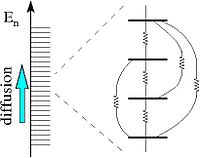Semilinear response

Okay, imagine you are playing with a toy car and your friend is driving it around. If your friend pushes the gas pedal down a little bit, the car will go faster, but not super fast. But if your friend pushes the pedal all the way down, the car will go super fast! The relationship between how much you push the pedal and how fast the car goes is called a linear response.
Now, let's say you have a different toy car that your friend can control with a remote. But instead of controlling the speed directly with a pedal, your friend controls it with a dial. If your friend turns the dial a little bit, the car will go faster, but not super fast. But if your friend turns the dial all the way up, the car will only go a little bit faster than when the dial was turned only a little bit.
This kind of relationship, where increasing something only makes a small change in the result, is called a semilinear response. It's like a mix of linear and nonlinear responses. In this case, the increase in speed follows a curved line as the dial is turned up, rather than a straight line like in the other example.
Scientists use the idea of semilinear response to study all sorts of things, like how a material will behave when it is stretched or how many fish will be caught when more people fish in a lake. It helps them understand how things change and react when different factors are increased or decreased.
Now, let's say you have a different toy car that your friend can control with a remote. But instead of controlling the speed directly with a pedal, your friend controls it with a dial. If your friend turns the dial a little bit, the car will go faster, but not super fast. But if your friend turns the dial all the way up, the car will only go a little bit faster than when the dial was turned only a little bit.
This kind of relationship, where increasing something only makes a small change in the result, is called a semilinear response. It's like a mix of linear and nonlinear responses. In this case, the increase in speed follows a curved line as the dial is turned up, rather than a straight line like in the other example.
Scientists use the idea of semilinear response to study all sorts of things, like how a material will behave when it is stretched or how many fish will be caught when more people fish in a lake. It helps them understand how things change and react when different factors are increased or decreased.
